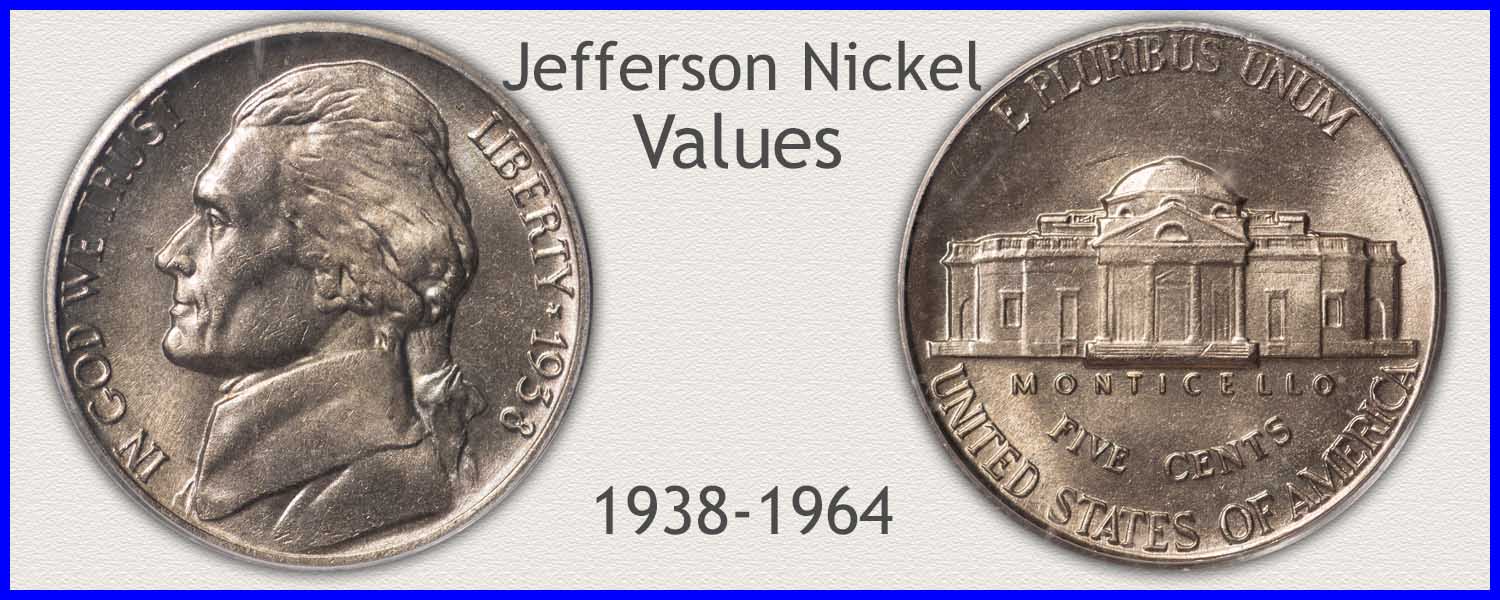Coin Values Moving with Precious Metals: Up-Dated 4/14/2025: Gold $3226 | Silver $31.88
1942 Nickel Value
Two main varieties of nickels were struck in 1942. The typical alloy with nickel and a silver alloy. 1942 nickel value depends on the variety.
A step by step method confirms date, the silver nickel, and mint striking the coin. All are combined to find how much a 1942 nickel is worth.
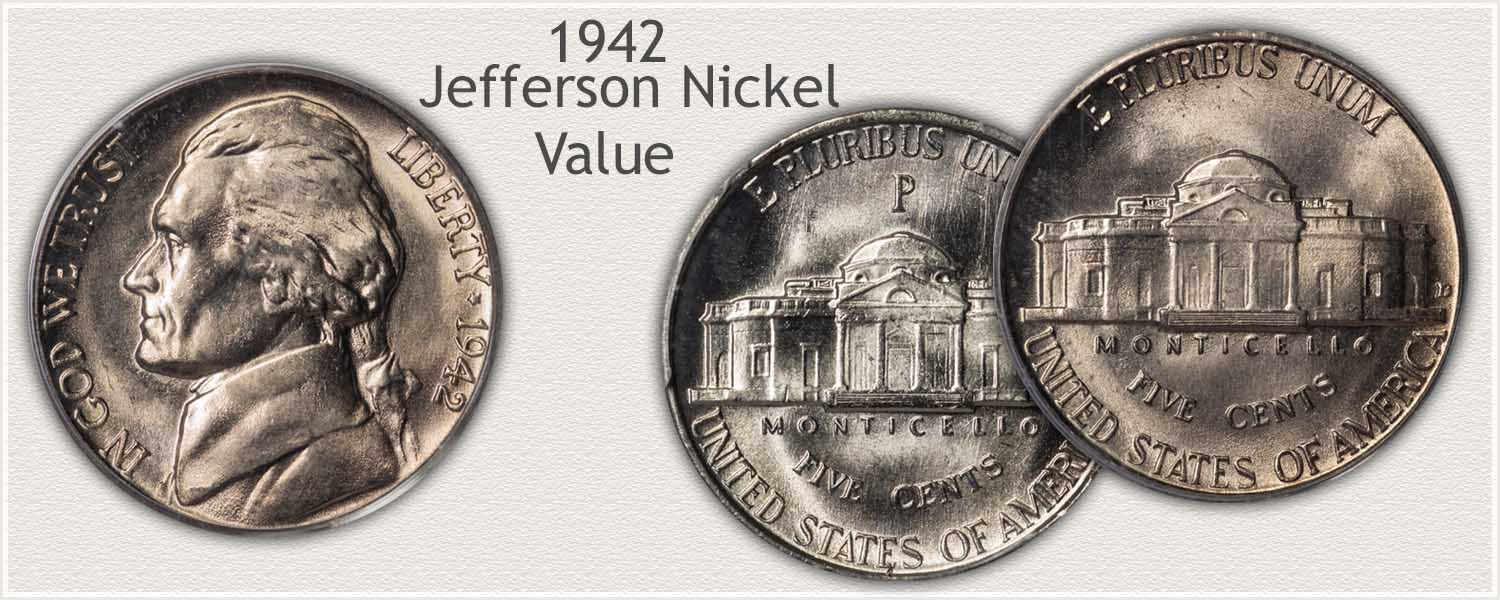
Steps Leading to Value:
- Step 1: Date and Mintmark Variety - Identify each date and its mintmark variety. Silver nickels were introduced in 1942, important to recognize.
- Step 2: Grading Condition - Condition of these nickels is important to collectors. Grade your coin comparing to images of nickels in different conditions.
- Step 3: Special Qualities - 1942 is one of the key years in the Jefferson series. Two alloys, and three mints; they are a theme collection all in one year.
| 1942 Jefferson Nickel Value | ||||
|---|---|---|---|---|
| Condition of Coin | ||||
| Date | Good | Fine | Extremely Fine | Mint State |
| 1942 Jefferson Nickel Value Up-Dated | 4/14/2025 | |||
| 1942 | $0.05 | $0.05 | $0.10 | $6.00 |
| 1942 D | $0.05 | $0.05 | $0.75 | $13 |
| Silver Jefferson Nickels of 1942 | ||||
| 1942 P | $1.28 | $1.28 | $1.28 | $7.67 |
| 1942 S | $1.28 | $1.28 | $1.28 | $7.50 |
The process to narrow the value range of your coin begins with a close look and conformation of date. Followed by steps to identify the different major and minor varieties of 1942 nickels.
Many of these old nickels are heavily worn, it is the few in nice condition standing out as premium coins. Grading condition in Step: 2 is important when reading the value chart. Handle your coins by the edges, under a single light source to gain a clear view.
Step 1: | Date and Mintmark Variety | Close Inspection Needed
Identify the Silver Varieties of 1942 Jefferson Nickels
A major change in the alloy of nickels in 1942 created the "silver nickels". Four distinct varieties of nickels were minted in the year with a change-over to the silver nickels. Each is very popular with collectors. Additionally, the silver nickels have an added value because of today's silver price.
Inspect closely all 1942 nickels using the images and descriptions of the varieties. A well-worn 1942 nickel, if the silver variety, is worth well above the "nickel alloy" variety.
1942 Jefferson Nickel
No Mintmark on Reverse: Philadelphia Mint Struck the Coin
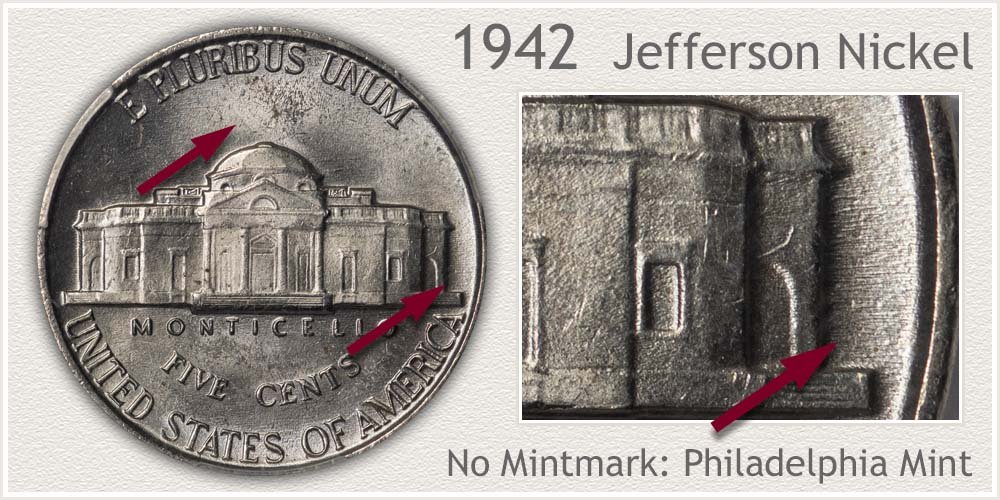
Beginning of 1942 the Philadelphia mint was still striking nickels of the standard nickel/copper alloy. Continuing the practice concerning mintmarks, these nickels from Philadelphia feature no mintmark.
Look on the reverse to the right of Monticello, if the area next to the rim is empty Philadelphia produced the coin. Also, if no mintmark is above the dome of Monticello, the space is empty, this confirms the Philadelphia nickel/copper variety 1942 issue.
1942-D Jefferson Nickel
"D" Mintmark on Reverse: Denver Mint Struck the Coin
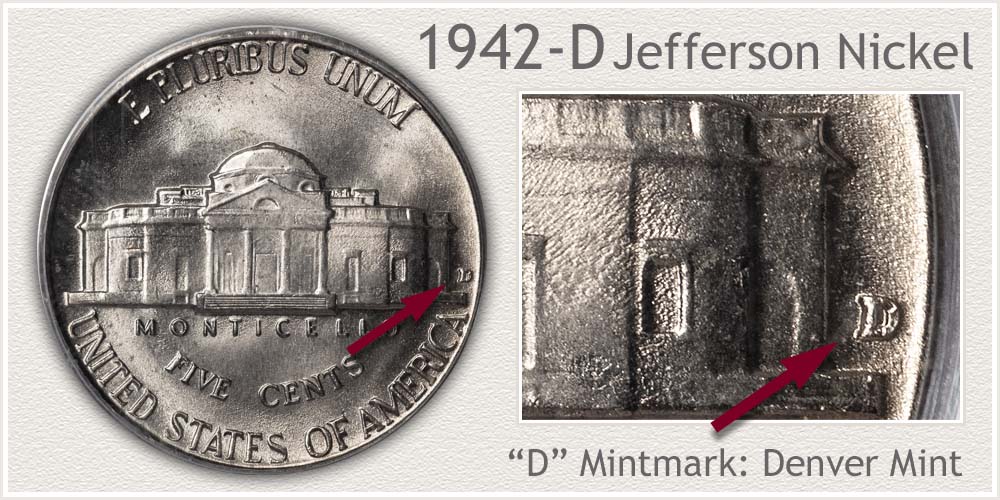
The Denver mint did not change to the silver alloy in 1942. All Denver mint 1942 nickels are the nickel/copper alloy of standard nickel coinage. Setting the coin apart and adding value is the very low 13,938,000 pieces produced. With attention drawn to the new "silver nickels" of the year, most Denver coins circulated for years.
Finding a lightly circulated Denver 1942 variety nickel is today finding a premium coin. Collectors seek coins without large nicks and heavy wear.
Denver placed a small "D" on the right side of Monticello in 1942 to identify its production.
U.S. Mint Introduces a Silver Alloy Nickel in 1942
1942-P Jefferson Silver Nickel
"P" Mintmark on Reverse: Philadelphia Mint Struck the Coin
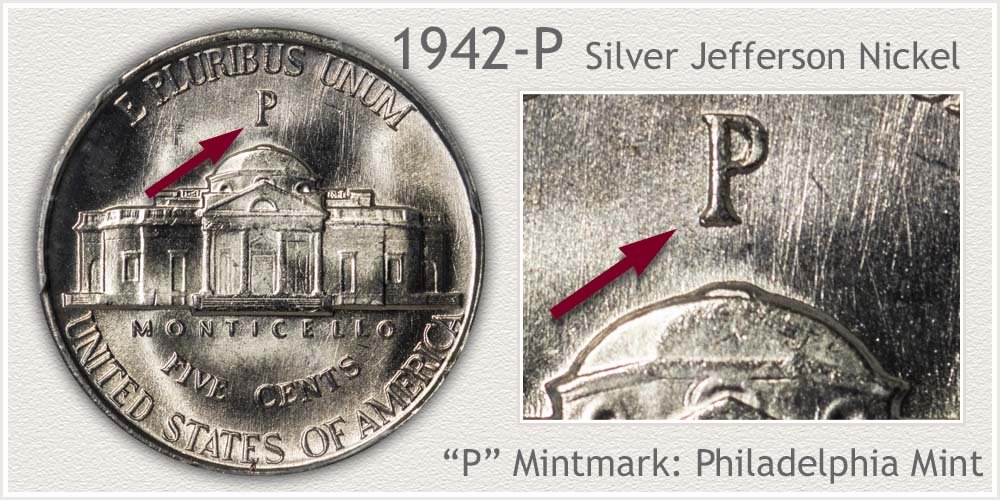
Philadelphia mint introduced the "silver nickel" in 1942. Ending production of nickel/copper alloy 1942 nickels early in the year and then changing to silver alloy nickels in the latter part of 1942. Philadelphia struck both varieties of nickels.
A clear indication of the silver nickel is the large "P" mintmark above Monticello.
- Philadelphia Silver Issue Variety: "P" Mintmark Above Monticello
- Philadelphia Nickel/Copper Variety: No Mintmark to right of Monticello or above Monticello
Notable is the split in production between the alloys resulted in low production of both. The silver 1942 nickel is the lowest mintage of all the years of the silver issues.
1942-S Silver Jefferson Nickel
"S" Mintmark on Reverse: San Francisco Mint Struck the Coin
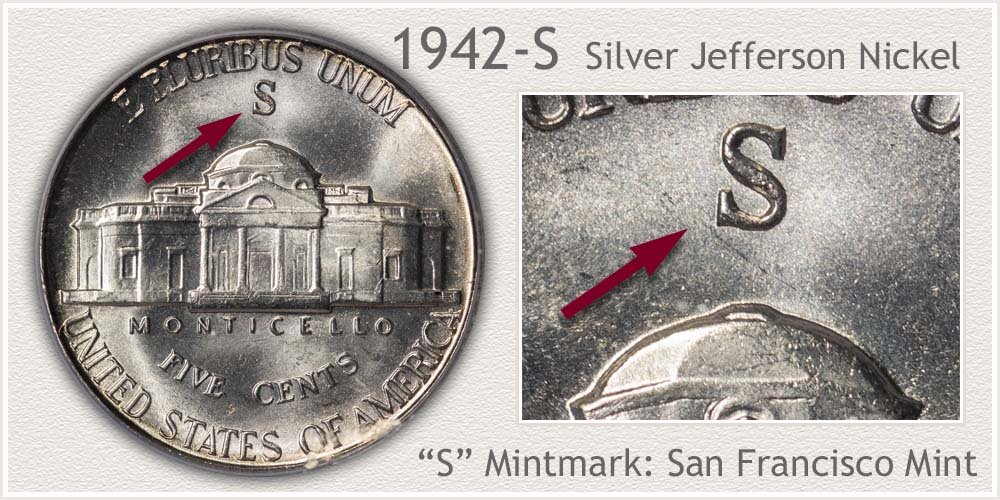
In 1942 the San Francisco mint struck the silver alloy nickel only. Just under 33 million pieces and they began entering circulation late in the year. All 1942 nickels from San Francisco are premium coins because of silver content.
A change in location and size of mintmark was also introduced to indicate the special silver content. On the reverse above Monticello a large "S" mintmark is the San Francisco silver nickel.
Step 2: | Grading Condition Narrows Value Range
1942 Jefferson Nickel Value is Conditional
Collectible coins are typically ones with the least amount of wear. A 1942 nickel with just light circulation wear is sought by many collectors because of affordability.
Grading coins detects wear if any, and judges the amount of wear. Use the images to compare your coin, a good match helps identify the grade and potential premium.
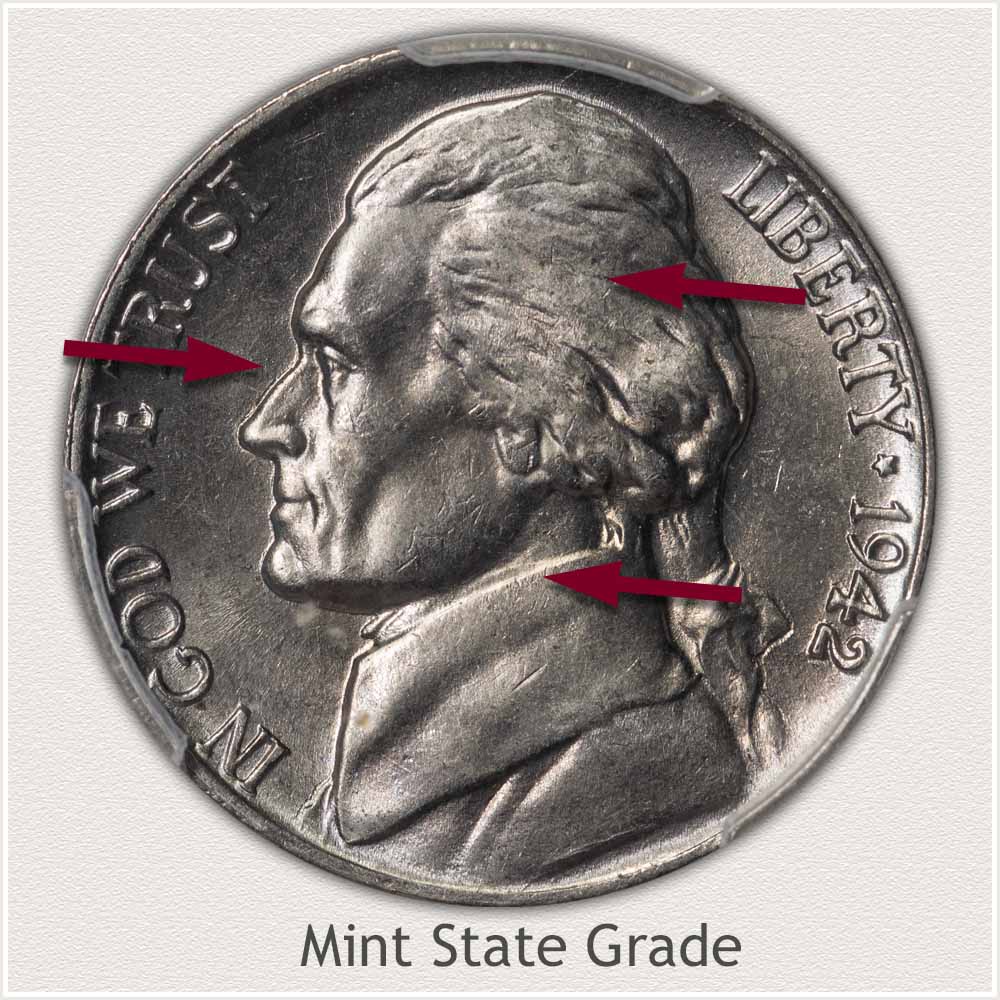
Mint State Grade: A mint state coin is an excellent example to see the amount of original design detail on a Jefferson nickel. No wear to the surface defines the grade.
These early era vintage nickels are well struck and highly contoured. Inspect the collar line at Jefferson's neck. In mint state condition this high area remains with luster and a fine texture is noticed to the metal. When tilting the coin, the luster moves along the collar line.
Continue to inspect other high areas to confirm lister rotates as the coin is tilted.
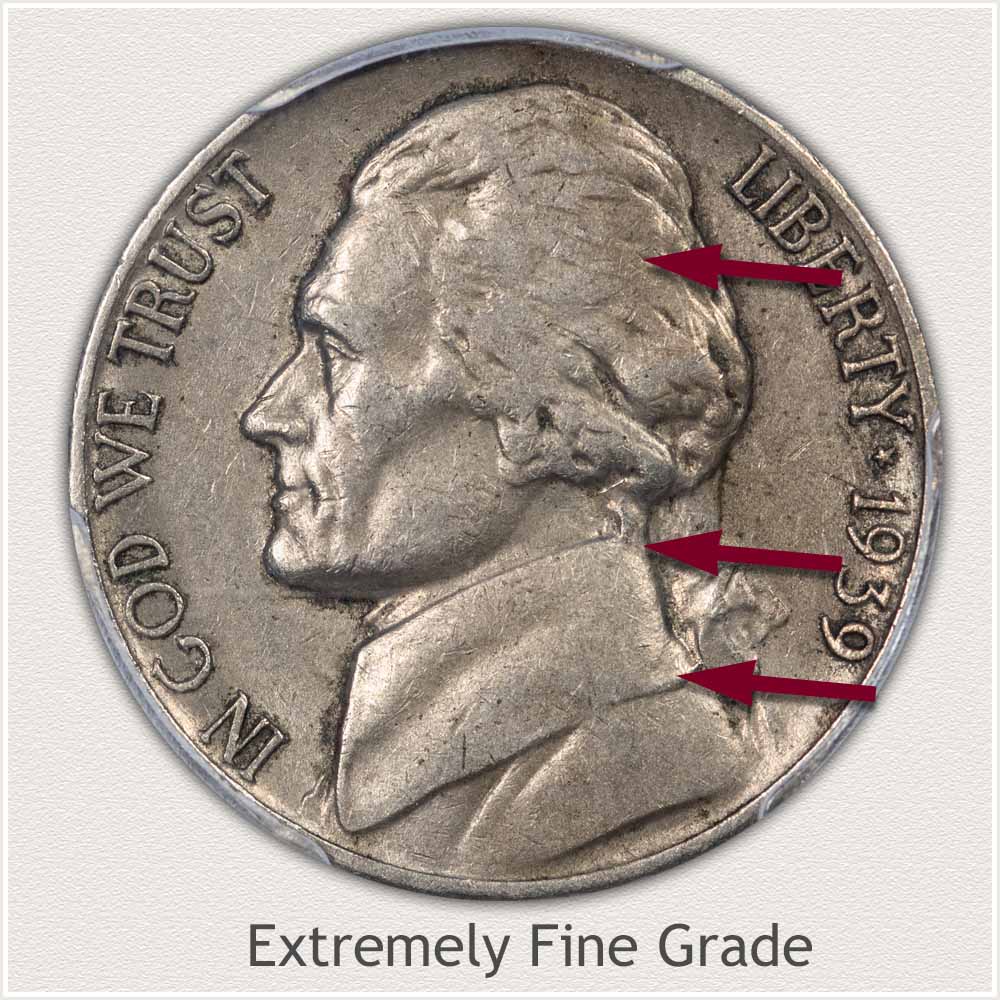
Extremely Fine Grade: One of the noticeable features of a circulated coin is the lack of shine to the surface. Wear has now removed luster and a smooth surface remains. When the wear is light, and only at high points a coin is considered in Extremely Fine condition.
Looking at the upper collar line at Jefferson's neck, luster is gone from the metal. A smoothness is present and a small flat area has developed along the collar under the jaw. Secondly, a line defining the lower edge of the collar is visible separating the shoulder area. Wear is visible and flatness is just a small area.
Most of the detail remains within Jefferson's hair and overall, the extremely fine grade coin is bold in appearance.
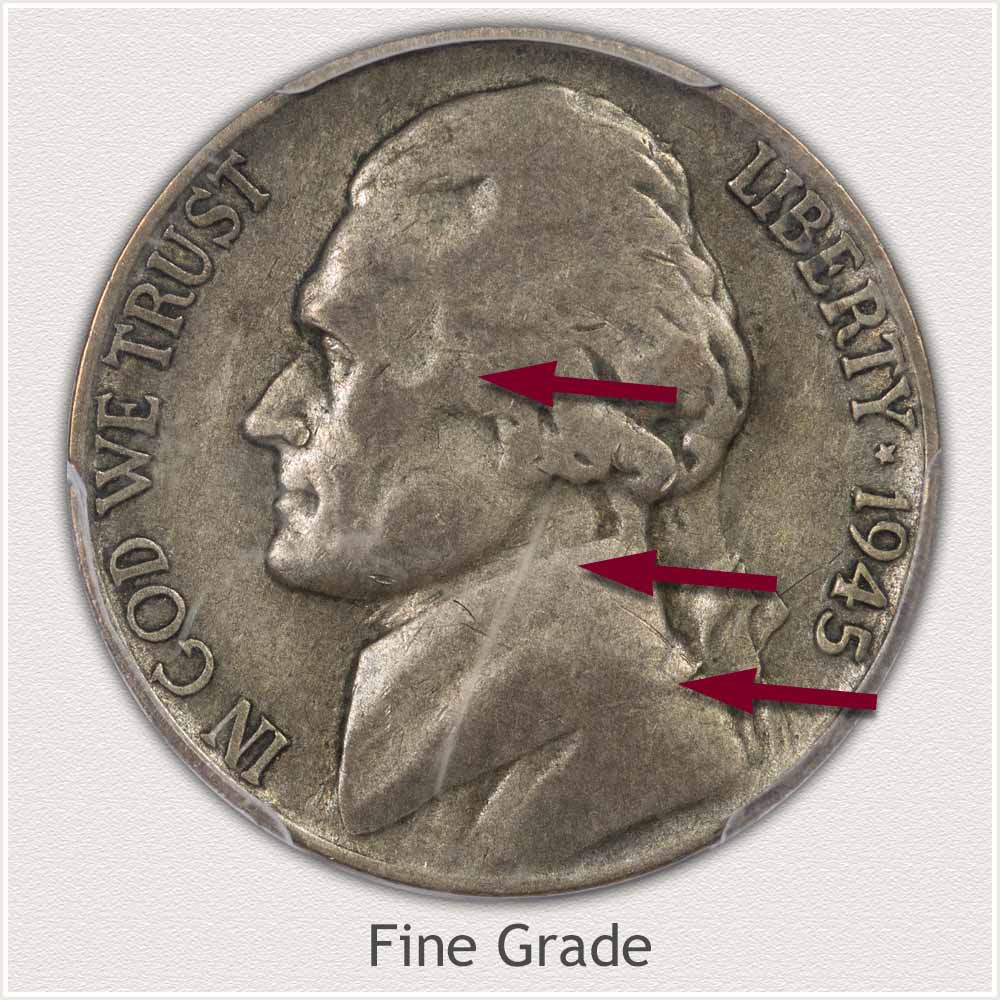
Fine Grade: Wear is noticeable and creating flat areas on a nickel in Fine grade. Helping define the condition is most flat areas are disconnected.
Jefferson coat collar is beginning to show a flat area within the center. The upper line at the neck is complete with flatness along the middle of the line. At the lower collar edge notice the merging with the shoulder and some of the line missing. This area of distinct merging helps define the grade. The size of the flat area is small.
Many features remain bold on Jefferson's face. His upper and lower cheek are flat but separate.
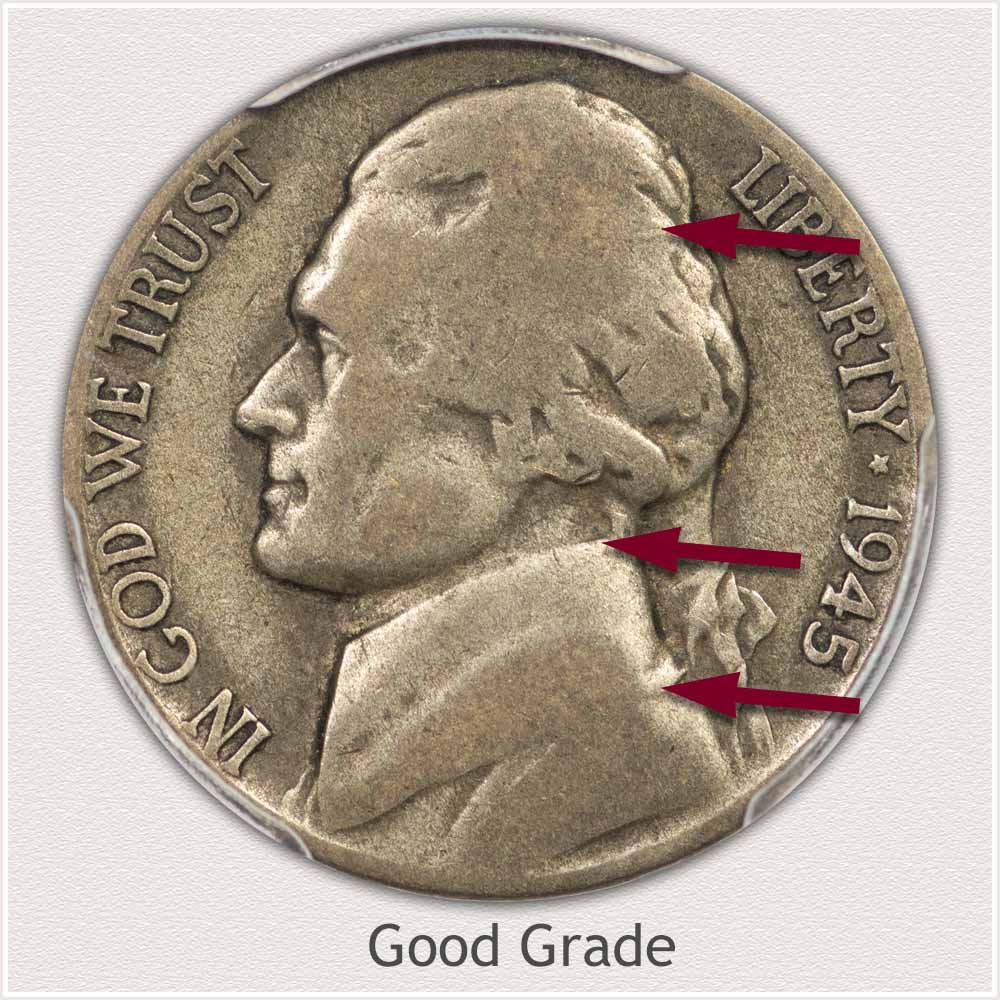
Good Grade: Wear, creating flatness, covers the majority of a nickel in Good grade.
Keeping a strong outline and many inner details, present a pleasing, although worn coin. Jefferson coat collar is now very worn, however, remains complete at the neckline. His shoulder and lower collar line are merged along most of the shoulder. Notice also the flat area in the center of the collar connecting to the shoulder.
Hair is flat extending from the top to the ear. Facial features are blending with the hair. These worn areas combined with extensive wear at the collar place a Jefferson nickel in the Good grade.
How to Video: Grading Jefferson Nickels
Additional descriptions and images are presented adding to the grading process.
Video, Images and Descriptions | Grading Jefferson Nickels
Step 3: | Special Qualities Enhancing Value
Valuable 1942 Nickel Collection
Special circumstances are part of a date collection of 1942 Jefferson nickels. A couple of "firsts" of U.S. coinage, multiple levels of affordability, scarcity and demand within a popular series. All contribute to a historical collection of nickels.
1942 began with the regular minting of coins with the nickel-copper alloy. By May of 1942 production of these nickels stopped. Nickel was needed for the war effort. In October of 1942 the composition of five cent pieces became 35 percent silver and 56 percent copper with 9 percent manganese alloy. The "Silver" nickels were now in production. A new major variety of Jefferson nickels was created. The nickel Five Cent denomination that replaced the earlier silver Half Dime denomination now contained silver.
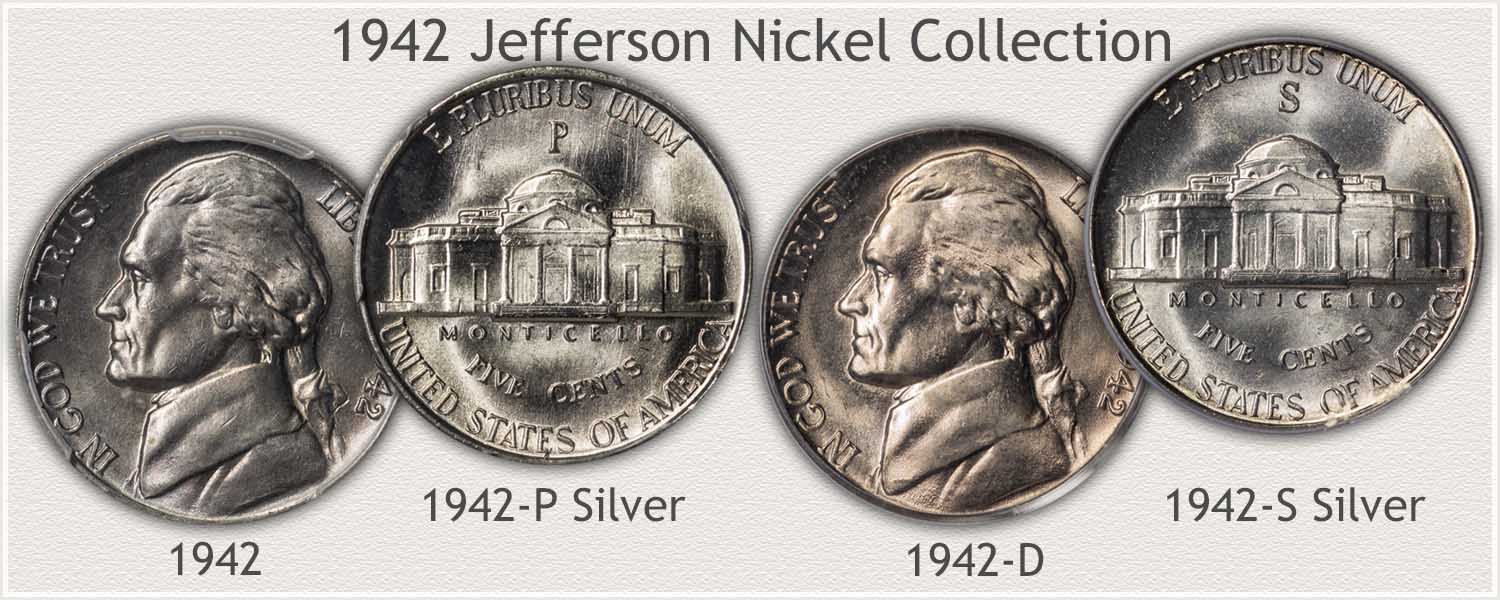
Two of the three mints coined silver nickels in 1942. The branch mint San Francisco and the main mint Philadelphia. A first for the Philadelphia mint is placing a mintmark on coinage. To help identify the silver issue nickels, a large "P" was placed above the dome of Monticello. San Francisco followed with a large "S". Denver mint, when tasked in 1943 to strike silver nickels, placed a "D" above Monticello.
Of note is the low total number of silver nickels minted dated 1942 - just over 90 million. Under 100 million minted is well below 1943 at 390 million; 1944 at 173 million; and 1945 at 215 million. 1942 is the scarce date of the silver variety.
Fortunately, many 1942 nickels, both silver and the nickel/copper alloy pieces survive today. These coins circulated for many years and very worn examples of the silver variety trade in quantities at their silver value. Affordable examples in lightly worn condition are excellent as a collection for young collectors to assemble. High grade gem quality coins carry high values and are in demand by advanced collectors. A 1942 theme collection of nickels includes a wide range in premiums attracting all levels of collector expertise and involvement.
1942 nickel/copper alloy nickels are also a very low mintage variety, total of Philadelphia and Denver just under 64 million. The nickel/copper variety 1942 nickel is also scarce.
The 1942 Circulation Strike Nickel Set Contains Four Coins
- 1942 Nickel/Copper | Philadelphia Mint
- 1942-P Silver | Philadelphia was the only mint to strike both alloys in 1942
- 1942-D Nickel/Copper | Denver Mint - a low mintage coin
- 1942-S Silver | San Francisco Mint
Each of the coins in the 1942 date set are historically important and scarce in overall context. A unique year for the Philadelphia mint producing both varieties and introducing the "P" mintmark.
References
U.S. Mint. 1966 U.S. Mint Annual Report.
https://nnp.wustl.edu/library/book/348/
U.S. Mint. 1943 U.S. Mint Annual Report
https://nnp.wustl.edu/library/book/336
Coin Values | CoinStudy Articles
Date by Date
In Depth Jefferson Nickel Values
1938 to 1964
Jefferson Nickel Values | Gaining Popularity
A key to Jefferson nickels and values is condition of the coin. Special attention is given to grading using images to compare and identify condition. Value charts now highlight the dates and mintmarks with premium listings.
Rare nickels are found throughout each series and many dates ranging from the beginning of the denomination to modern nickels. A listing of rare nickels with images to help identify the important features.
Print the Coin Values Worksheet
List your Jefferson nickels and record their values. Should you decide to sell... use the worksheet as an invoice and packing slip when sending coins through the mail to dealers. It indicates you have done your coin values homework.
Coin Value Guide | How to Value a Coin Collection
Placing a value on a coin collection is done by following a step by step method. Each series is identified with images, important dates are highlighted. Grading condition, one of the important steps is accomplished with images of grades to compare your coins. An organization of your coins is part of the process.
★ Coin Values Discovery finds 1942 Jefferson Nickel Value and...
All old U.S. coin values. It is an excellent index with images of the different coin series. Match your coins and follow the link to in-depth values. Charts, grading images and a step by step procedure uncovers how much your box of old coins is worth.
